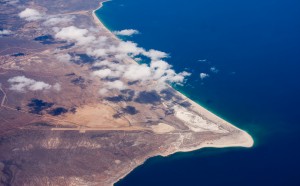13 December 2013
Microbial memories carry the pulse of past ocean climates
New data from ocean microbes in the Soledad basin off the coast of Baja, Calif., confirms a La Niña-like effect cooled surface waters 4,000 to 10,000 years ago.
Previous studies of one microbe species in sediment cores found cooler waters during this period of the Holocene, but scientists were not sure whether La Niña was at play, or more local effects like deeper waters welling to the surface were responsible.
Trade winds move warm waters from east to west over periodic cycles that occur over several years. La Niña – the cooling effect – brings cooler, drier weather to the United States. It is the opposite of warmer, wetter El Niño-induced seasons. In addition to these global effects, currents and local weather conditions also circulate deep, cold, nutrient-rich waters to the surface, an upwelling that replenishes nutrient-depleted surface waters.
Adding data from two more microbial species — one a summer-loving variety and another that lives in deeper waters — researchers now confirm the La Niña cooling effect. Hannah Grist, a graduate student at the University of Colorado, Boulder, presented the new results at a poster Thursday morning at the American Geophysical Union’s Fall Meeting in San Francisco.
Changing water conditions also change the lives of oceanic species like foraminifera. These short-lived, microscopic, sea-dwelling critters drift through surface waters. They also pack their life experiences of ocean temperatures and seasons into the chemical content of their shells: magnesium-calcium ratios in their shells are higher in warmer water than in colder waves.
“Each shell, even if it is 14,000 years old, can reveal hourly, daily changes in temperatures,” Grist said.
One species, Globigerina bulloides, lives close to the ocean surface during the spring, while another, Globigerinoides ruber, surfaces in the summer. Grist studied elemental ratios in samples of both species. By comparing the two over spring and summer, researchers estimated whether cooling was caused by the global “ocean thermostat” of La Niña, or whether seasonal upwelling was responsible. The shells showed signs that the ocean was cooled by both springtime upwelling and ocean-wide effects.
Past climate models have predicted oceanic responses to solar radiation and atmospheric conditions. This data now adds seasonal variation to the mix.
“As climate models evolve they have to adapt to fit these observations,” Grist said. “These data can inform climate models of the past, which can eventually be used to predict future climate.”
– Jyoti Madhusoodanan is a science communication graduate student at UC Santa Cruz



 GeoSpace is a blog on Earth and space science, managed by AGU’s Public Information staff. The blog features posts by AGU writers and guest contributors on all sorts of relevant science topics, but with a focus on new research and geo and space sciences-related stories that are currently in the news.
GeoSpace is a blog on Earth and space science, managed by AGU’s Public Information staff. The blog features posts by AGU writers and guest contributors on all sorts of relevant science topics, but with a focus on new research and geo and space sciences-related stories that are currently in the news.